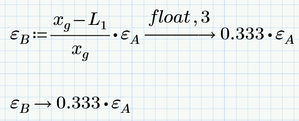Community Tip - Have a PTC product question you need answered fast? Chances are someone has asked it before. Learn about the community search. X
- Subscribe to RSS Feed
- Mark Topic as New
- Mark Topic as Read
- Float this Topic for Current User
- Bookmark
- Subscribe
- Mute
- Printer Friendly Page
Symbolic evaluation precision
- Mark as New
- Bookmark
- Subscribe
- Mute
- Subscribe to RSS Feed
- Permalink
- Notify Moderator
Symbolic evaluation precision
Hi, I would like to simplify the solution, but I want the rest of the program to use all of the numbers.
The Float command doesnt not allow that request. It uses the new numerical value.
Also, In my case, I can't change the display precision. It is not available while using symbolic evaluation.
Thank you
Camille
Solved! Go to Solution.
- Labels:
-
Civil_Engineering
-
Mathcad Usage
Accepted Solutions
- Mark as New
- Bookmark
- Subscribe
- Mute
- Subscribe to RSS Feed
- Permalink
- Notify Moderator
As epsilon.B seems to be undefined, you can't use numeric evaluation whits its ability to format the displayed result the way you'd like it being shown.
Unfortunately the symbolic evaluation does not know any commands or modifiers to format the result.
The "float" modifier affects the precision of the whole calculation, not just the displayed result.
In case you don't mind the red error which stems from the numeric as epsilon.B is not defined, you may do it as shown below:
As you can see, epsilon.B still has full precision. Don't be tempted to use an inline evaluation with "float", as this will limit the precision of epsilon.b:
Another approach comes to my mind but it involves kind of cheating and I am not sure if you can use it in your work. You may define epsilon.A:=1 somewhere out of sight (to the right of the sheet or in a collapsed region at the top) and then use epsilon.A similar to a unit in a numerical evaluation which you can format as you like.
You should also add clear.sym(epsilon.A) so epsilon.A still shows in symbolic evaluations.
The drawback of course is, that you have to add epsilon.A (or epsilon.A^2 in the last region) manually and this sure is failure prone. And it gets worse if more unknown variables are added (like A, E in your sheet).
Another approach which may not look so clean, though, would be to set up all as function of the unknowns
epsilon.B(epsilon.A):=....
which are evaluated numerically only when all unknowns are specified.
- Mark as New
- Bookmark
- Subscribe
- Mute
- Subscribe to RSS Feed
- Permalink
- Notify Moderator
As epsilon.B seems to be undefined, you can't use numeric evaluation whits its ability to format the displayed result the way you'd like it being shown.
Unfortunately the symbolic evaluation does not know any commands or modifiers to format the result.
The "float" modifier affects the precision of the whole calculation, not just the displayed result.
In case you don't mind the red error which stems from the numeric as epsilon.B is not defined, you may do it as shown below:
As you can see, epsilon.B still has full precision. Don't be tempted to use an inline evaluation with "float", as this will limit the precision of epsilon.b:
Another approach comes to my mind but it involves kind of cheating and I am not sure if you can use it in your work. You may define epsilon.A:=1 somewhere out of sight (to the right of the sheet or in a collapsed region at the top) and then use epsilon.A similar to a unit in a numerical evaluation which you can format as you like.
You should also add clear.sym(epsilon.A) so epsilon.A still shows in symbolic evaluations.
The drawback of course is, that you have to add epsilon.A (or epsilon.A^2 in the last region) manually and this sure is failure prone. And it gets worse if more unknown variables are added (like A, E in your sheet).
Another approach which may not look so clean, though, would be to set up all as function of the unknowns
epsilon.B(epsilon.A):=....
which are evaluated numerically only when all unknowns are specified.










